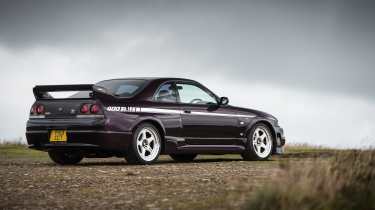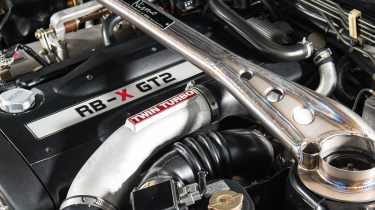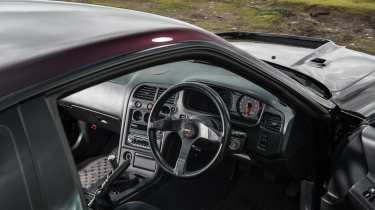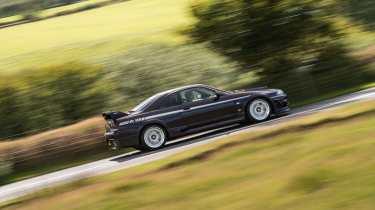Nissan Skyline GT-R Nismo 400R (1997) review – the JDM icon with a hypercar price
The R33 is the GT-R JDM fans love to hate, yet the Nismo 400R is one of the most coveted by collectors. It's also one of the best
I’ve loved Japanese performance cars since the early days of this magazine when I used to devour stories about the latest and maddest Imprezas and Evos. Later, when I was lucky enough to drive them, the pull of their unique, almost savage focus on grip and agility grew stronger. The Mitsubishi Evo in particular became my sweetheart. However, one car stood above even my beloved Mitsubishi Evo. The Nissan Skyline GT-R. The R33-generation Nismo 400R? Short of a full Group A R32 at Bathurst, it’s the Holy Grail.
Bigger, heavier and wilfully complex, in some respects it’s the very opposite of the rabid, supernaturally agile Mitsubishi, but something about its weird chassis acronyms, bruising styling and massive tuning potential meant that, for me at least, it was always the ultimate exponent of the art.
Nissan Skyline GT-R Nismo 400R history
Just 44 examples of the 400R were hand-built at Nismo’s Omori factory, so the search was long and at times frustrating, but in the end they turned up an absolute peach. This car has covered just 42,000km and it’s finished in perfect ‘LP2’ or Midnight Purple. Aside from Nismo’s own and unique yellow 400R as immortalised in the Gran Turismo game series, this is the Skyline colour. It just had to be Midnight Purple.
More reviews
Group tests
Reviews
I think it’s only right and proper to declare my deep lust for this car from the outset. In fact, I’m pretty nervous about the whole thing. I mean, what if it’s terrible? Or, even worse, just a bit, well, ‘so what?’. I think I could cope with it being absurdly stiff, threatening to bounce me from the road, or some mighty, comedy turbo lag and spiky, heart-in-mouth handling. But if it’s a bit flat, a bit slow, a bit imprecise… that would be awful. Too awful even for the carbonfibre bonnet, those achingly cool LM-GT1 white-faced split-rim alloys and the magnificent graphics to overcome.
So what exactly is this car? Stripped-out road-racer? Homologation special? Well, not quite either of those things, but with elements of both. The Nismo 400R was launched in November 1997, inspired by the Skyline GT-R LM that had raced at Le Mans in 1995 and 1996. Rather unfortunately, this production-based racer was facing the likes of the McLaren F1 GTR in the GT1 class so could do no better than 10th overall (5th in class) in its first year and 15th overall (10th in class) in ’96, despite returning with a bigger version of its legendary straight-six engine, now displacing 2.8 litres.
As an illustration of the arms race in the GT1 category, Nismo returned to Le Mans in 1997 not with a Skyline-based car but the incredible R390 GT1, complete with a carbonfibre monocoque and 3.5-litre twin-turbocharged V8. Just two road versions were built and only one was actually sold to a customer. They paid around £650,000.
The 400R is no GT1, then. But it is a comprehensive reworking of the already pretty extraordinary R33 GT-R.
Engine, gearbox and technical highlights
Nismo left no stone unturned in its quest to build the ultimate road-going Skyline. Forget a little bit of extra boost and some stiffer dampers; the 400R went much, much further. Out went the iconic RB26DETT engine and in its place came the Le Mans-proven RB-X GT2 unit engineered by Reinik, the motorsport department of Nissan Kohki (itself the in-house powertrain division at Nissan).
Reinik has impeccable pedigree, having created the engines for the all-conquering Group A Skylines back in the glory days, along with motors for F3, the Dakar and, of course, Le Mans. The RB-X GT2 utilised a reinforced block that was bored and stroked (87 x 77.7mm) to make 2771cc. It also featured N1-spec turbos with steel internals, a forged crankshaft and connecting rods, a new engine management system, optimised cylinder heads, revised intake and exhaust systems (titanium from the cats back), an air-cooled oil cooler and a new intercooler system. The RB-X GT2 (what a name!) produces 395bhp at 6800rpm and 347lb ft at 4400rpm.
The solutions throughout the car were no less radical, from the 50 per cent lighter carbonfibre driveshaft to the titanium front strut-brace, carbonfibre bonnet, double-element adjustable carbonfibre rear wing, forged three-piece wheels with 275/35 ZR18 tyres, the new front bumper scooped out with various cooling channels and widened to accommodate the 50mm increase in track… the list goes on.
The suspension was also retuned with much stiffer bushes, new Bilstein dampers and aggressive spring rates with a 30mm drop in height. The 400R still features that unique ATTESA ET-S PRO four-wheel-drive system with an ‘Active LSD’ at the rear (as seen in the contemporary Skyline GT-R V-Spec). These days a manufacturer would call that torque-vectoring and get very excited about it. It also features the Super HICAS four-wheel-steering system.
Inside you can’t see all of that technology. In fact the 400R feels simple. Maybe even ordinary. The black plastic dash is not a thing of beauty, for example. But the little details reveal snippets about the Skyline GT-R in general and the 400R in particular. The seats, trimmed in an odd velour-type material, feel fantastically grippy and supportive. You sit low, legs out quite straight, and the pedals have a real heft and precision to them. Gone is the ugly four-spoke airbagged steering wheel of other Skylines and in its place a gorgeous 360mm Nismo item with a carbonfibre horn push emblazoned with the 400R logo.
The slim, cylindrical gearknob looks a bit aftermarket but is in fact titanium. Of course. The unique instrument cluster has a speedo reading to 320kph (199mph) and the rev-counter goes yellow at 8, red at 9 and doesn’t stop until 11. Even the three little auxiliary gauges on the centre console are unique: from left to right they still display the amount of power sent to the front wheels, oil temp and boost pressure respectively, but they show finer graduation for more detailed information, while the boost gauge reads up to 1.4bar. And you can see that heavily sculpted bonnet ahead, the plank of carbonfibre behind and the blistered arches when your eyes flick to the door mirrors.
Performance ride and handling
I twist the elegant key and, before the big straight-six booms into life, a young female Japanese voice chirps something enthusiastically from a small and rather mysterious rectangular box attached to the underside of the dash above my left leg. I don’t know what the hell it means, but it makes me smile and the nerves disappear. This is going to be awesome.
The engine churns slowly at first and then booms into a heavy, tuneless idle. The sound is deep, powerful, the sort of noise that isn’t piercingly loud but jangles your bones. Like the R35 GT-R, the Skyline has a feel of engineered heft to everything it does. And a real sense of raw feedback. The steering is heavy but quite quick, perhaps on account of the rear-wheel steering, and despite the weight there’s a really smooth, clean feel to the rack. The drivetrain somehow imparts a sense of inertia but also energetic response, too.
The 400R is 1550kg and it feels it, but there’s an athleticism bubbling away under the surface. I’d expected a hellishly hard ride, but although the 400R jiggles and fidgets at lower speeds, it doesn’t take long before the dampers start to find their range even on these lumpy, jagged roads. It’s a hell of a lot more pliant than the new GT-R Nismo, that’s for sure.
What it doesn’t have, not right away anyway, is the immediacy of a new GT-R. It doesn’t assault you with terrifying performance nor hurl itself into corners with such startling speed. I’m sure back in ’97 its pace across the ground would have been just as shocking as a GT-R or 911 Turbo is today, but it can’t compress each corner nor the following straights with that relentless, almost frantic surge that’s come to be the norm. Of course, you’re still travelling at a serious lick and the beauty of every bit of road unfurling just that bit slower is that you can enjoy the process, swept up in the feeling of it all, rather than agog at the physics.
The RBX-GT2 is a gritty, industrial wonder. The lesser 2.6-litre straight-sixes found in normal Skylines have a real off-boost lethargy and in standard form they still feel held back even when the turbos are blowing hard. If ever an engine needed to be tuned with freer breathing and a tickle more boost, it’s the RB26DETT.
The 400R’s six is different. It still feels like a big, heavy engine but the throttle response is cleaner even when the turbos are only just waking up, and from around 3500rpm to over 8000rpm it chomps through each gear with a delicious roar overlaid with the hissing of the big cold-air intake system and the whistle and chirrups of the turbocharger plumbing. It sounds like a living, breathing monster of an engine and creates a character at odds with the technofest you might expect. The chunky five-speed ’box just adds to the physical drama of extracting the 400R’s performance.
The chassis has the same physicality but does feel less intuitive. The ATESSA ET-S PRO system sends 100 per cent of torque to the rear wheels on corner entry and then uses ABS sensors, lateral and longitudinal G sensors and throttle opening information to determine when to apportion power to the front wheels. Up to 50 per cent of drive can be sent forwards.
The Super HICAS rear-wheel-steering system steers in the opposite direction to the front wheels initially to create agility, then switches to steering in harmony with the fronts to control the rate of yaw. That’s the theory at least. The reality is that the 400R can at first feel slightly wayward and always requires space and a dose of bravery to really explore.
So the 400R turns in with real assurance, the rear-wheel-steer system effectively shortening the wheelbase. Body control is good, the car turning and settling in one clean action. But from mid-corner things get a bit spooky. Instead of keeping that lovely neutral feeling, the 400R drives through that phase and quickly into something approximating oversteer.
I say that because the rear tyres aren’t necessarily sliding, it’s just that the steering system seems to push the rear of the car wider and wider. That means no understeer but a slightly unnerving, slightly unnatural yaw moment. This sensation takes time to grow used to and even longer to start to exploit.
> Nissan GT-R Nismo (R35, 2014 - 2025) review – Godzilla on steroids is a Japanese icon
However, the 400R never snaps into oversteer and with patience you can tune into its balance and gradually start to pick up the pace until you’re throwing everything at it. This car has uprated AP Racing brakes and they’re sensational – the pedal with that solid, heavyweight feel of a good racing setup – so you can brake right into turns, feel the rear axle drive the front tyres into the corner, and then unleash the howling RB-X GT2 engine.
The 400R needs a bit of aggression to really start to make sense, and driven with this degree of commitment everything feels more natural and less disjointed. It actually starts to seem small and light, so much so that you find yourself flinging it around like a hot hatch rather than treating it as a big rear-wheel-drive coupe.
On one final drive across the moor, everything clicks. It’s a cool evening and the engine seems hungrier than ever for the dense air, the steering shimmies and wriggles over the worst bumps but is full of feel, and I manage to get the 400R in that sweet spot where it locks into corners on entry but floats out of them just on the edge of oversteer without tipping over into a clumsy slide.
It feels sensational, a compelling mix of heavyweight engineering and lithe responses with a unique soundtrack and a setup that requires work to understand but then offers rich reward. Later I find myself daydreaming about taking it on a road trip to Spa or maybe down to the Route Napoléon. Tokyo, Bathurst, the south of France, Exmoor… It’s all immaterial really. What matters is being in the 400R.
Nissan Skyline GT-R Nismo 400R specs
| Engine | In-line 6-cyl, 2771cc, twin-turbo |
|---|---|
| Power | 395bhp @ 6800rpm |
| Torque | 347lb ft @ 4400rpm |
| Weight | 1550kg (259bhp/ton) |
| 0-60mph | 4sec (claimed_ |
| Top speed | 186mph (claimed) |
| Value now | £1m+ |












